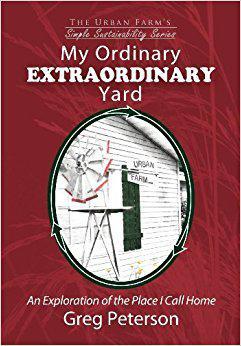Your Green Lawn
By Greg Peterson
Oh, the double meaning there. AND why the heck is Greg the Urban Farmer talking about growing a lawn? Primarily because it drives me absolutely crazy how the status quo grows winter lawns. IMHO they are doing it ALL wrong—too many chemicals, too much water and not enough organic material.
 So here is how ‘they’ do their lawn. Sometime between Aug 15 and September 15 the crews come in to scalp (cut the grass very short) and then ‘they’ de-thatch the lawn. Interestingly, both of these processes remove many of the nutrients and organic material required for healthy soil and growth.
So here is how ‘they’ do their lawn. Sometime between Aug 15 and September 15 the crews come in to scalp (cut the grass very short) and then ‘they’ de-thatch the lawn. Interestingly, both of these processes remove many of the nutrients and organic material required for healthy soil and growth.
What “they” start with. Dirt, no organic material and some lonely seeds.
The next step of the process is to seed. And seed they do—right on top of the dirt, which is devoid of many of the nutrients and all of the organic material that will keep the seed moist while it germinates.
Then they water—lots of water, multiple times each day with the high spots drying out and lacking in germinated seeds while the low spots collect puddles where the seeds rot.

Really their lawn 3 weeks later.
Why is this up for me now? I have been running since the beginning of September and so I have been watching this process as the local municipality reseeds their front lawn – which is close to a half an acre so it is a major production. They started on September 30th with the scalping and dethatching, then later that week they seeded and here we are over three weeks later and there are still great big patches of dirt with no grass growing. The first logical question is: how long does it take for rye grass to germinate? 5 to 10 days and they are well outside that window. You get the picture, the way ‘they’ are doing it is ineffective and wastes huge quantities of water.
But there is a better way.
In our back yard here at the New Urban Farm there is a small patch (18 x 26 inches) of dirt where my sweetie likes to grow grass for the cats. So we took on reinvigorating the space for our own patch of grass. On October 13 we began by leveling the space, added a nice layer of compost (there was no thatch to remove so I had to add my own organic material), planted the seeds then added another half inch of compost on top.

Our lawn after 15 days.
And here is the biggest clincher of the deal? We watered once a day in the morning then a mere 5 days later there were many little green sprigs coming up through the compost. Here we are two weeks later with a full lawn. This is a better way.
Lawns… am I all for them? Not really, primarily because according to the book Lawns, they are the crop that we in the United States spend the most money on by purchasing fertilizers, pesticides and herbicides that are typically way over-applied. Then, we bag the clippings and send them off to the local landfill.
However, if we were to compost the grass clippings for organic material, use natural fertilizers and build an ecosystem in our lawns that is healthy…I am all for them. Hey, I like my lawn. It feels good as I wander through my garden in my bare feet and provides me with a nice amount of green composting materials to jump start my compost pile.
Happy Gardening







